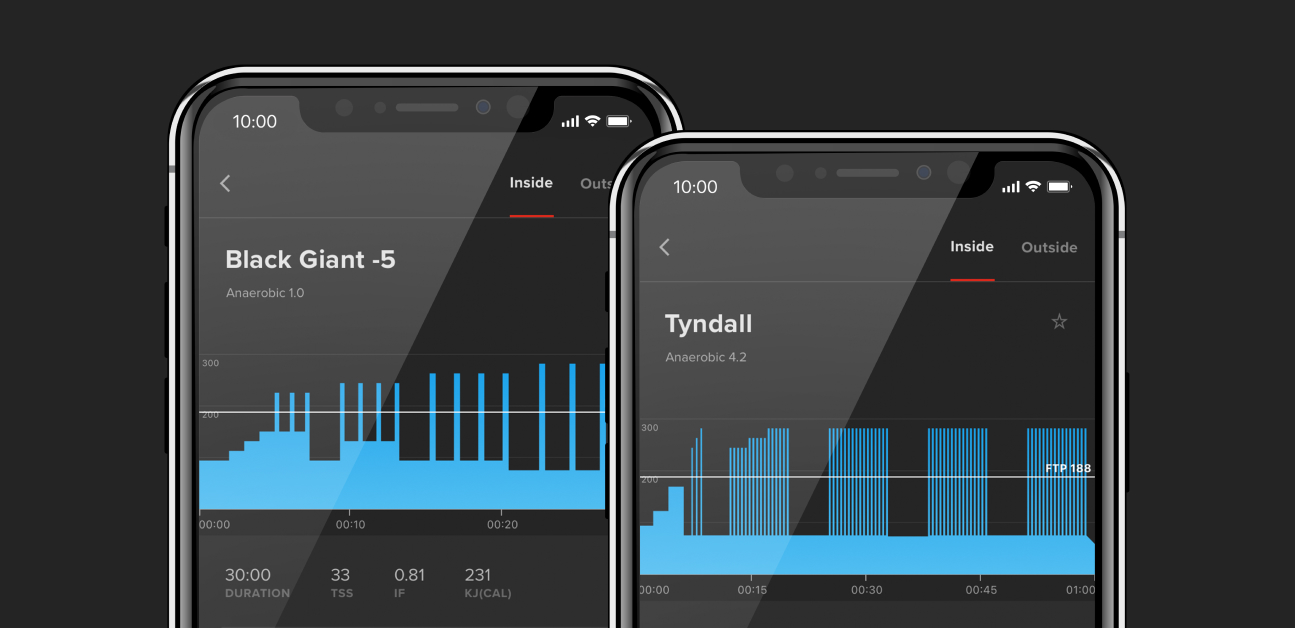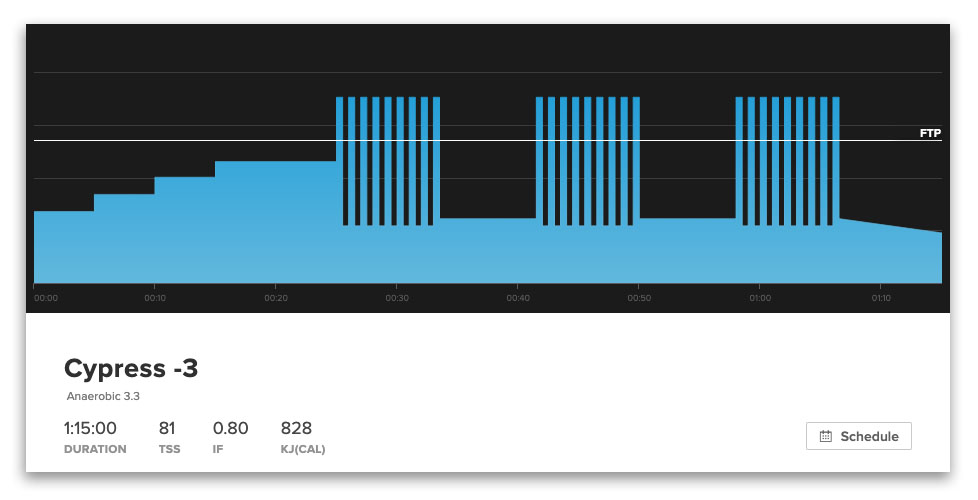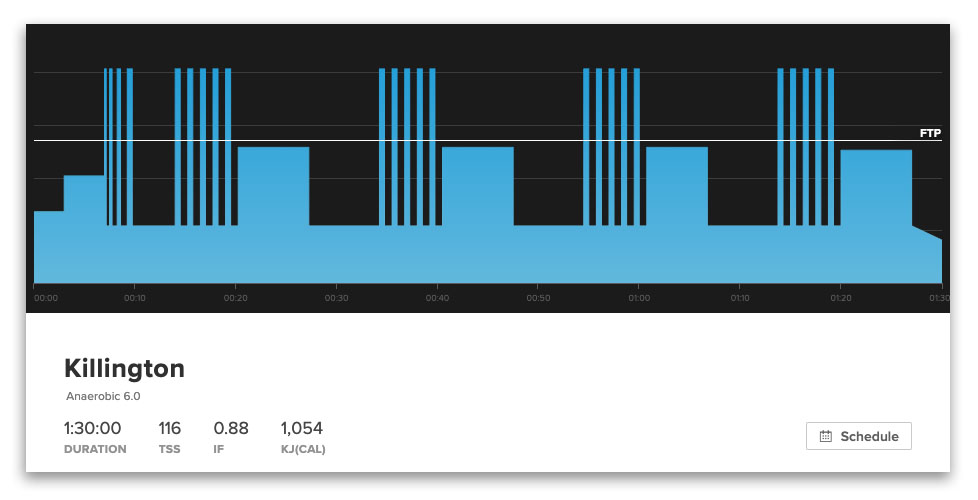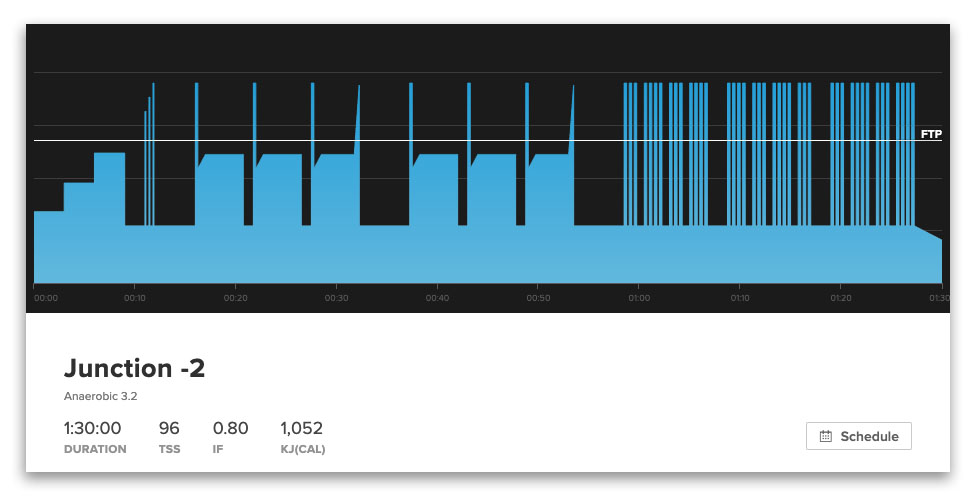Anaerobic Workouts & Intervals For Cyclists: How They Make You Faster

Endurance sports are primarily aerobic, powered by a process that utilizes oxygen to generate muscular energy. But cyclists also frequently utilize the body’s anaerobic system to fuel shorter, high-intensity efforts. These efforts let you push over hills, close gaps in the pack, and surge to win races. By training with anaerobic intervals you can become a more effective competitor.
Key Takeaways
- The anaerobic system powers short efforts at high intensity.
- Anaerobic efforts occur frequently in racing— over hills, out of corners, and during attacks.
- Increasing your anaerobic capacity will make you more powerful during high intensity efforts.
- Workouts with intervals above 120% FTP specifically target your anaerobic system.
- Anaerobic workouts are taxing and require good fueling, plenty of rest, and an accurate FTP.
What is Anaerobic Metabolism?
The energy currency of life is a molecule called adenosine triphosphate, or ATP. The mitochondria in your cells convert your body’s fuel stores into ATP, which your muscles use to do work.
When your body needs to use a lot of energy for short periods, a process called anaerobic metabolism quickly produces ATP without the use of oxygen. It’s an effective way to generate immediate energy, but it produces byproducts more rapidly than your body can clear them. This naturally limits its use to about thirty seconds.
For most cyclists, anaerobic metabolism powers a small but meaningful portion of time spent on the bike. Whenever you need to sprint, raise the pace, or temporarily increase intensity, anaerobic metabolism is responsible for handling your muscular energy demands.
Aerobic vs. Anaerobic
The rest of your time spent riding is primarily fueled by aerobic metabolism, which requires oxygen and produces energy more slowly. The upside is that aerobic metabolism can be sustained almost indefinitely, and it can even reprocess and utilize the byproducts of anaerobic metabolism. But its overall output is limited, and on its own, it can’t fuel the high-intensity surges common to riding a bike.
The aerobic and anaerobic systems represent two of your body’s three energy systems— distinct methods for generating ATP and utilizing energy in different situations. The third is the neuromuscular system, which powers the shortest and most intense efforts lasting just a few seconds. Like the anaerobic system, the neuromuscular system works in the absence of oxygen.
None of your body’s energy systems operate in isolation, and through the course of a ride or race your muscles utilize all three in varying proportions. The harder you ride, the greater the contribution of the anaerobic system, and the less sustainable the pace for long periods.
More On Energy Systems
The Importance of Anaerobic Capacity
Every energy system’s capabilities can be improved with training. Since the aerobic system is the most sustainable source of energy on the bike, most cycling training focuses on developing your aerobic base.
But no matter how finely tuned your aerobic system, some efforts exceed its capabilities. In these instances, your anaerobic system steps up to the plate, and how effectively it does so depends on your anaerobic capacity. Anaerobic capacity is a measurement of your anaerobic system’s ability to generate power and is typically measured with a 30-second sprint test. Riders with high anaerobic capacities can surge far above FTP to initiate attacks and close gaps, and can easily power over small hills and out of corners to leave competitors behind. These efforts are crucial in almost every cycling discipline—especially in stochastic events like criteriums, mountain bike races, and cyclocross. Luckily, anaerobic capacity is highly responsive to training, and with the right workouts, you can directly target these skills.
Adaptive Training
Get the right workout, every time with training that adapts to you.
Check Out TrainerRoadAnaerobic Intervals for Cyclists
The most effective way to develop your anaerobic capacity is with high-intensity intervals at 120% FTP or above that activate your type 2b muscle fibers. These efforts are necessarily quite short and are usually alternated with brief rests that allow your energy stores to partially recover. The first few intervals may feel surprisingly easy, but don’t let your guard down. Each interval gradually becomes more challenging as your energy stores run low and muscular capacity to clear lactate is pushed to its limit.
Some anaerobic interval workouts also include efforts at VO2 Max, Threshold, or Sweet Spot intensities. These mixed sessions simulate the varied efforts found in real races.
Example Anaerobic Workouts

Cypress -3
This is a great example of an “on-off” workout, in which short efforts alternate with equally short recoveries for a lot of productive time at intensity. In this case, a relatively long warmup at 85% FTP activates your aerobic system, before you tackle 3 sets of 9×30 second repeats at 130% FTP.

Killington
This very challenging workout alternates sets of 30-second anaerobic repeats with 7-minute intervals at 95% FTP, effectively imitating the experience of attacking from a pack mid-race. These efforts place a high demand on both aerobic and anaerobic capabilities.

Junction -2
This workout combines two distinct interval formats for a varied and productive session. First, two sets of “race winners” start with a 15-second anaerobic effort at 140% FTP, immediately followed by 4 minutes at 90% FTP. As their name suggests, these efforts mimic the demands of a race-winning attack. The second part of the workout is composed of 3 sets of microbursts— very short and intense 15-second anaerobic efforts at 140% FTP, with equally short recoveries between.
Tips for Success in Anaerobic Workouts
Anaerobic workouts can be extremely challenging for some athletes, and more naturally enjoyable for others. Wherever you fall on the spectrum, a few general guidelines can help you get the most out of these workouts.
Fueling
Anaerobic efforts are almost exclusively glycolytic, which means they are entirely fueled by sugars. This makes fueling especially important for these workouts. Top up your glycogen stores with good pre-workout nutrition, and be prepared to take in simple carbohydrates like gels during your workout to sustain your entire effort. Read more on fueling and nutrition here.
Rest and Recovery
High-intensity workouts take focus. They require commitment and motivation, factors shown by studies to be highly influenced by rest. Attempt a hard workout after a night of poor sleep, and whether or not you’re physically capable of completing it, you might not have the willpower to see it through.
These workouts also place big demands on your muscles. Residual fatigue can prevent you from reaching your target power, negatively affecting the quality of your workout. For all of these reasons, you should only attempt anaerobic workouts when you’re well-rested and recovered. Click here for more on rest and recovery.
Accurate FTP
At anaerobic intensities, the slightest increase or decrease in wattage can make a huge difference, both in how you feel and how the workout affects your body. As a result, having your FTP accurately determined with a recent Ramp Test is important for anaerobic workouts. If your FTP is set too high or too low, your workout could be too easy or too hard— and less productive overall.
Use Moderation
Anaerobic workouts and intervals are exciting and can be extremely productive. But they are also highly fatiguing and are easy to overdo. Training Plans typically limit anaerobic workouts to a maximum of two or three per week, and whether you’re following a plan or not it’s best to stay within this limit and avoid doing them on consecutive days. For more on balancing intensity and structure, click here.

